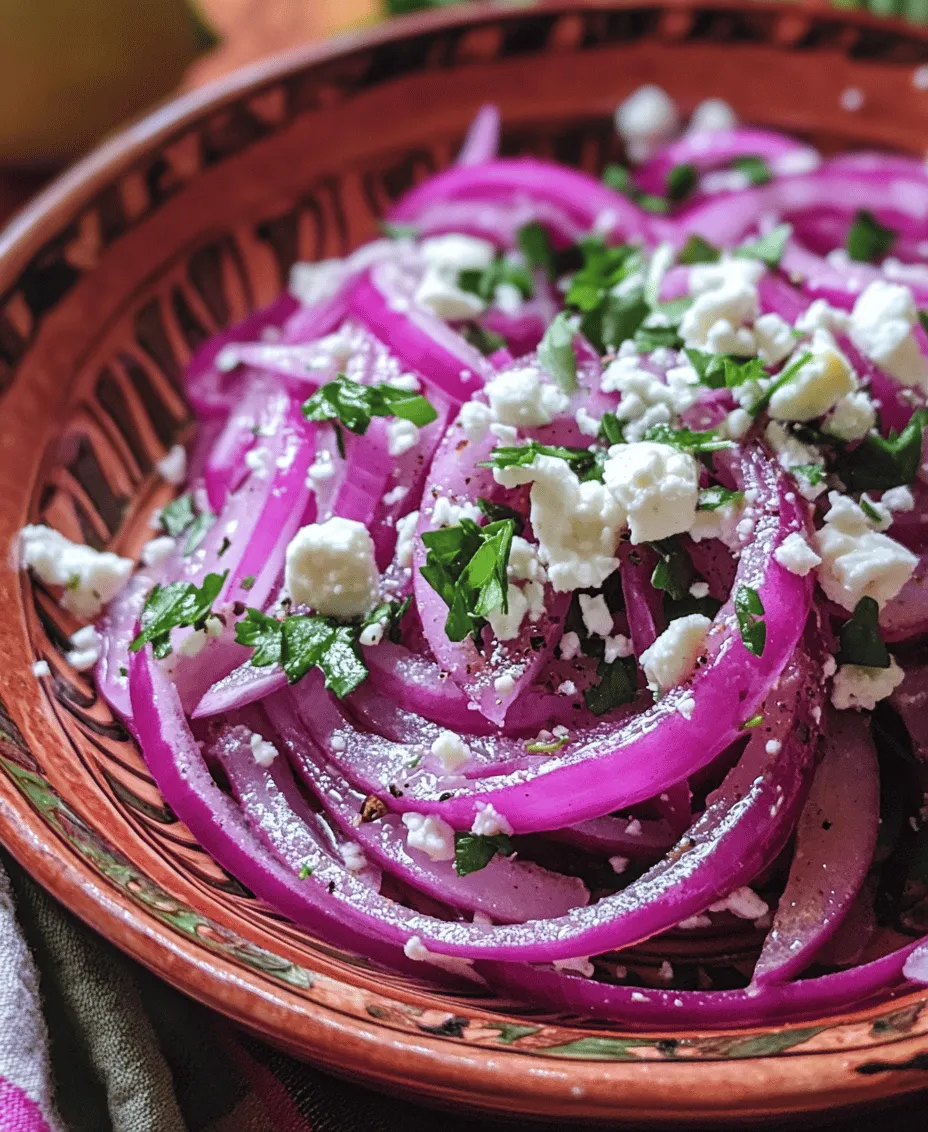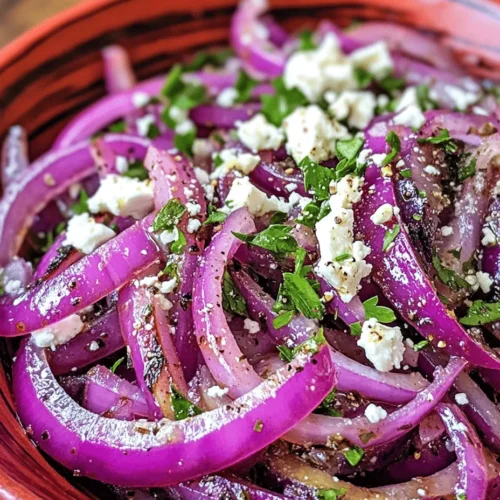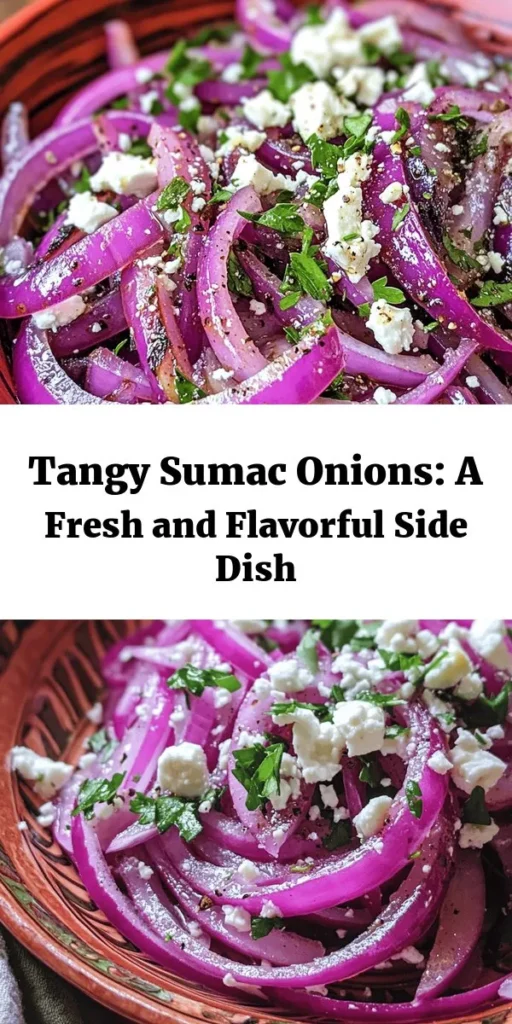Introduction
Onions have long been a staple in kitchens around the world, serving as a foundational ingredient that enhances the flavor of countless dishes. Their versatility allows them to be used in various forms—raw, sautéed, roasted, or pickled—each bringing a unique taste and texture to meals. Among the many culinary traditions that celebrate the use of onions, Middle Eastern cuisine stands out, particularly through its beloved pickled and marinated onion varieties. One such delightful creation is Tart & Tangy Sumac Onions, a recipe that not only showcases the vibrant flavor of onions but also elevates them with the addition of sumac, a spice known for its unique tartness.
Sumac, with its bright red hue and tangy profile, has gained popularity in recent years, making its way from traditional Middle Eastern dishes to modern kitchens worldwide. The combination of onions and sumac creates a perfect balance of flavors, offering a refreshing accompaniment to grilled meats, salads, and grain bowls. This recipe for Tart & Tangy Sumac Onions is not only simple to prepare but also incredibly versatile, making it a must-try for anyone looking to enhance their culinary repertoire.
In this article, we will delve into the enchanting world of sumac, explore the significance of onions in cooking, and provide a detailed breakdown of the ingredients needed to create this invigorating dish.
Understanding Sumac: The Key Ingredient
The Origins and Characteristics of Sumac
Sumac is a spice derived from the dried and ground berries of the Rhus genus, which is predominantly found in the Mediterranean region and parts of the Middle East. Its rich red color and coarse texture make it a visually appealing addition to any dish. Traditionally, sumac has been used for centuries in various cultures, celebrated for its tart flavor that mimics the acidity of lemon or vinegar.
Flavor Profile
The flavor profile of sumac is both tangy and slightly fruity, providing a unique complexity that can elevate the simplest of ingredients. When sprinkled over dishes, it adds a delightful zesty kick, making it an excellent seasoning for everything from grilled meats to roasted vegetables. The brightness of sumac works particularly well with onions, enhancing their natural sweetness while imparting a refreshing acidity that can transform the overall taste of a dish.
Health Benefits of Sumac
Beyond its culinary uses, sumac is packed with health benefits. Known for its antioxidant properties, it is rich in compounds that help combat oxidative stress in the body. Additionally, sumac has been used traditionally to aid digestion and support overall health. Incorporating sumac into your diet can not only enhance flavors but also contribute positively to your wellness.
Common Uses of Sumac in Different Cuisines
In Middle Eastern cuisine, sumac is a beloved ingredient, often sprinkled over salads like fattoush or used in spice blends such as za’atar. It is also commonly featured in marinades and dressings, adding depth of flavor. As its popularity grows, sumac is finding its way into fusion dishes and contemporary recipes, making it a trendy choice for home cooks and professional chefs alike.
The Role of Onions in Cooking
The Significance of Onions
Onions are one of the most widely used vegetables in the culinary world. Their ability to enhance flavor, texture, and aroma makes them indispensable in a variety of cuisines. Whether you’re making a hearty stew, a fresh salad, or a savory sauce, onions serve as a foundational component that brings depth to the dish.
Types of Onions and Their Uses
There are several types of onions, each with its unique flavor and culinary applications. Here are a few common varieties:
– Yellow Onions: The most versatile onion, yellow onions have a balanced flavor that becomes sweeter when cooked. They are ideal for soups, stews, and caramelization.
– Red Onions: Known for their vibrant color and slightly milder flavor, red onions are often used raw in salads, sandwiches, and as garnishes. They are also excellent for pickling, as they retain their color and crunch.
– White Onions: These have a sharper, more pungent flavor, making them perfect for salsas and Mexican dishes.
– Shallots: With a delicate sweetness and mild flavor, shallots are often used in dressings and sauces.
Health Benefits of Onions
Onions are not just flavorful; they also offer numerous health benefits. They are low in calories and rich in vitamins and minerals, particularly vitamin C, vitamin B6, and manganese. Onions are also high in antioxidants, which can help reduce inflammation and promote heart health. The sulfur compounds found in onions may aid in detoxification and support immune function.
Flavor, Texture, and Aroma
The contribution of onions to flavor cannot be overstated. They provide a natural sweetness that balances savory and tangy elements in dishes. When sautéed, onions develop a caramelized exterior that adds richness and depth to meals. Raw onions, on the other hand, offer a crisp texture and sharp flavor that can brighten up salads and sandwiches.
Ingredients Breakdown
To prepare Tart & Tangy Sumac Onions, you’ll need a handful of simple ingredients that come together to create a deliciously vibrant dish. Here’s a detailed breakdown of each ingredient:
Red Onions
Red onions are the star of this recipe. Their sweet, mild flavor and striking color make them the perfect choice for pickling. When sliced and marinated, red onions maintain their crunch while absorbing the tangy flavors of the sumac and other ingredients. They not only bring aesthetic appeal but also a delightful taste that enhances any dish.
Olive Oil
Quality olive oil is essential for this recipe. It adds richness and depth to the sumac onions, helping to meld the flavors together. The best olive oils are cold-pressed and extra virgin, ensuring that you get the most robust flavor and health benefits. Olive oil is also known for its heart-healthy properties, making it a beneficial addition to your culinary creations.
Lemon Juice
Lemon juice plays a critical role in balancing the flavors of the Tart & Tangy Sumac Onions. Its acidity cuts through the richness of the olive oil while enhancing the natural tanginess of the sumac. Freshly squeezed lemon juice is recommended for the best flavor, as it provides a bright and zesty kick that lifts the entire dish.
Honey or Agave Syrup
While optional, adding a touch of honey or agave syrup can provide a delightful contrast to the tanginess of the sumac and lemon juice. This hint of sweetness balances the overall flavor profile, making the onions more palatable for those who may be sensitive to tartness. A little goes a long way, so feel free to adjust to your taste.
Salt
Salt is a crucial ingredient in this recipe, as it enhances the flavors of the other ingredients and helps to draw out moisture from the onions. Using a good quality sea salt or kosher salt will give you the best results. The right amount of salt will not only elevate the taste but also contribute to the overall texture of the pickled onions, ensuring they remain crisp and flavorful.
In summary, Tart & Tangy Sumac Onions combine the delightful crunch of red onions with the unique flavor of sumac, creating a versatile dish that can elevate a range of meals. From salads to grilled meats, these sumac onions add a refreshing burst of flavor that is hard to resist. Stay tuned as we continue to explore the simple preparation methods and serving suggestions for this delightful recipe.

Fresh Parsley and Feta: Garnishes that Add Color, Texture, and Additional Flavor
Completing the vibrant presentation of Tart & Tangy Sumac Onions, fresh parsley and feta cheese serve as the perfect finishing touches. Parsley adds a pop of bright green color and a fresh herby flavor, while feta contributes creamy richness and a salty bite. Together, they not only enhance the visual appeal of the dish but also elevate its taste, creating a delightful balance with the tanginess of the onions and the aromatic qualities of sumac.
Step-by-Step Instructions for Tart & Tangy Sumac Onions
Creating the perfect Tart & Tangy Sumac Onions involves a few essential steps. Follow this comprehensive guide to ensure your onions are flavorful and well-prepared.
Step 1: Prepare the Onions
Start by selecting fresh onions, preferably red onions for their mild flavor and beautiful color. Slicing them properly is crucial for even marination. Here’s how:
1. Peel the Onions: Remove the outer skin carefully to expose the firm flesh.
2. Slice Thinly: Use a sharp knife to slice the onions into thin rings or half-moons. Aim for about 1/8 inch thickness. Thinner slices will absorb the marinade more effectively and soften beautifully as they marinate.
Step 2: Salt the Onions
Once sliced, it’s time to draw out excess moisture from the onions. This step is essential for achieving the desired texture and flavor.
1. Salt Generously: Place the sliced onions into a bowl and sprinkle a generous pinch of salt over them. Toss the onions gently to ensure they are evenly coated.
2. Let Sit: Allow the salted onions to sit for at least 10-15 minutes. During this time, the salt will draw out moisture, making the onions softer and more flavorful.
Step 3: Make the Dressing
The dressing is what gives the Tart & Tangy Sumac Onions their signature flavor. Here’s how to create it:
1. Combine Ingredients: In a small bowl, whisk together olive oil, fresh lemon juice, sumac, and a pinch of pepper. The ratio of oil to lemon juice should be balanced—generally, 2 parts oil to 1 part lemon juice works well.
2. Taste and Adjust: It’s important to taste the dressing and adjust the acidity and seasoning to your preference. If it’s too tangy, add a bit more olive oil; if it lacks brightness, a touch more lemon juice may be needed.
Step 4: Combine and Marinate
Now that your onions are prepared and your dressing is ready, it’s time to combine everything.
1. Rinse and Drain: Rinse the salted onions under cold water to remove excess salt. Drain thoroughly and pat dry with a paper towel.
2. Mix Together: In a mixing bowl, combine the rinsed onions and the dressing. Toss gently until the onions are well coated.
3. Marinate: Cover the bowl with plastic wrap or transfer the mixture to a sealed container. Let this marinate in the refrigerator for at least 30 minutes, allowing the flavors to meld. For optimal taste, consider marinating for 1-2 hours or even overnight.
Step 5: Final Adjustments Before Serving
Before serving, make sure to taste the marinated onions one last time. Adjust the seasoning as necessary; a sprinkle of more salt or sumac can often enhance the overall flavor. The onions should be tangy, with a hint of saltiness and a fresh, bright flavor profile.
Pairing Suggestions
Tart & Tangy Sumac Onions are versatile and can complement a variety of dishes and cuisines. Here are some excellent pairing suggestions:
Middle Eastern Dishes
This onion preparation shines alongside Middle Eastern staples. Consider serving it with:
– Kebabs: The acidity of the onions cuts through the richness of grilled meats.
– Falafel: These crispy chickpea balls paired with tart onions create a delightful contrast.
– Meze Platters: Include them on a platter with hummus, baba ganoush, and stuffed grape leaves for a colorful spread.
Mediterranean Meals
Tart & Tangy Sumac Onions can elevate Mediterranean dishes, such as:
– Grilled Fish: The bright flavors complement the richness of grilled salmon or seabass.
– Roasted Vegetables: Add them to a dish of roasted eggplant, zucchini, and bell peppers for an extra layer of flavor.
– Salads: Toss them into salads for a zesty kick, especially with grains like quinoa or bulgur.
Modern Twists
Incorporate these onions into contemporary meals for a creative flair:
– Topping for Burgers: They add an unexpected zing when piled high on beef, chicken, or veggie burgers.
– Tacos: Use them as a fresh topping for tacos, enhancing the flavors of grilled meats or beans.
– Grain Bowls: Add to bowls filled with grains, proteins, and vegetables for a nutritious, well-rounded meal.
Nutritional Information
Understanding the nutritional benefits of Tart & Tangy Sumac Onions can help you appreciate this dish even more. Here’s a general overview based on a serving size of about 1/4 cup of the marinated onions:
– Calories: Approximately 45-50 calories
– Fat: Around 4-5 grams, primarily from olive oil
– Carbohydrates: About 7-8 grams, mostly from the onions
– Protein: Less than 1 gram
Vitamins and Minerals
This dish is rich in vitamins and minerals, including:
– Vitamin C: Present in both the onions and lemon juice, supporting immune function and skin health.
– Vitamin K: Found in parsley, important for bone health and blood clotting.
– Antioxidants: Onions contain quercetin, an antioxidant that may help reduce inflammation.
Including Tart & Tangy Sumac Onions in your meals not only adds flavor but also contributes beneficial nutrients to your diet. The health benefits of sumac itself—known for its antioxidant properties—further enhance its appeal as a nutritious ingredient.
Conclusion
Tart & Tangy Sumac Onions are a simple yet transformative addition to any meal. Their vibrant flavor profile, characterized by tanginess balanced with a hint of saltiness, makes them an excellent condiment or side dish. The ease of preparation means you can whip them up in no time, and the potential for creativity in serving opens the door to countless culinary adventures.
By experimenting with sumac and discovering its place in your cooking repertoire, you can elevate everyday dishes to new heights. Whether enjoyed alongside Middle Eastern favorites or incorporated into modern meals, these onions are sure to impress with their bold flavors and appealing texture. Embrace the zest of Tart & Tangy Sumac Onions and enjoy the delightful impact they bring to your dining experience.



